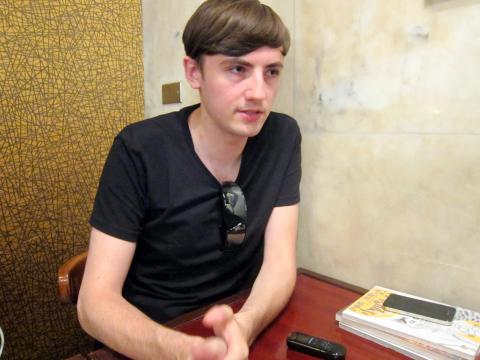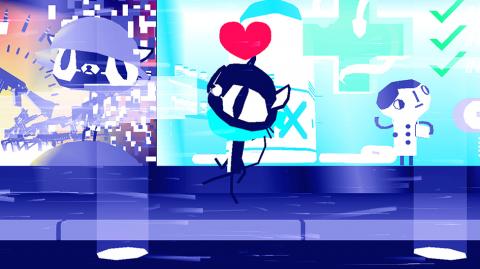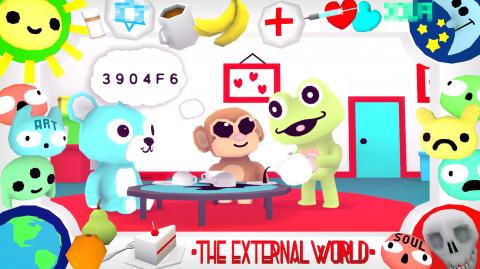David O’Reilly’s animation is a world away from Disney’s. His stories sometimes play out like a surrealist dream, infused with disturbing imagery, dark humor and angst. His style is raw and minimalist, stripping 3D animation models to their bare, pixelated form.
With his lack of concern for the conventions of typical computer-animated movies, the 26-year-old Irish animator has not only won a large number of online followers, but international accolades including the coveted Golden Bear at the Berlin International Film Festival in 2009 for Please Say Something, a short animation made entirely at home in his room with little, if any, budget. His works can be viewed online free of charge.
On Aug. 22 the maverick 3D animator gave the Taipei Times an animated introduction to what he had bought at Guanghua electronics market (光華商場) and an even more enthusiastic talk about his upcoming visit to Next Media Animation TV (動新聞, NMA.tv).

Photo Courtesy of David O’Reilly and Kavalan International Short Film Festival
“They [NMA.tv] are doing it [animation] in such a visual way that people can understand. It’s well-written, funny and so over the top ... They also throw away the idea of style as long as it reads ... I think what they do is great and just as valid as anything else,” said O’Reilly, who had arrived in Taiwan earlier this month to attend the Kavalan International Short Film Festival, which hosted a program of his animated films.
The young artist’s interest in NMA.tv is illuminating, especially when one considers the stripped-down approach he has developed as an independent animator over the years. O’Reilly was only 15 when he started to take on odd jobs at Cartoon Saloon (the studio behind Oscar-nominated The Secret of Kells) in his hometown of Kilkenny, Ireland, where he was trained in drawing and painting. Dropping out of school and moving to London at 19, the young animator took a day job with Studio AKA and worked for Shynola (a powerhouse whose resume includes animation for Radiohead’s Kid A) by night. He has never formally studied computer animation.
“People kind of had this fear about computer animation [around the year of 2000],” he says. “They were suspicious of this new technology. But it was also a genuine fear. People were losing their jobs. All the people who taught me how to draw were generally against computer animation. I felt it was a fear-based opinion, so I taught myself all the computer stuff in my spare time when I was in London and started to get jobs with it.”

Photo Courtesy of David O’Reilly and Kavalan International Short Film Festival
But it was in low-rent Berlin, where he “could do his own things without taking on any commercial work,” that O’Reilly was able to focus on his own creative projects for the first time and created a series of solo animation shorts including Please Say Something, which subverts the cartoon cat-and-mouse trope.
Like his choice of moving to Berlin, O’Reilly’s aesthetics are strongly influenced by economics. By trying to do things in the simplest way possible, the animator significantly reduces the amount of time that goes into producing his animation, which involves “the most mundane process to fix technical things and get the image out,” said O’Reilly, who currently resides in Los Angeles.
One extreme example of O’Reilly’s minimalism is Octocat Adventure (2008), a crudely drawn animation made using Microsoft Paint and posted on YouTube under the alias of nine-year-old Randy Peters. The story about a red cat head with eight long legs looking for his parents generated an enthusiastic response from netizens. O’Reilly later revealed his true identity and asserted that the work proves that something so fake and artificial can still produce real emotions as long as it is based on a good idea or has a good story.

Photo Courtesy of David O’Reilly and Kavalan International Short Film Festival
Economics aside, O’Reilly says that his minimalist approach to animation is also rooted in French director Robert Bresson’s notion of authenticity. The young artist mentioned the filmmaker and theorist’s questioning of how photographic imagery can be made to feel real despite the fact it is all fake.
“His [Bresson’s] solution is to basically strip everything down, to take away any excess detail. I think that by trying to hide your style and never showing off as a director was kind of his way of dealing with the problem of everything being fake. Ultimately if you can disappear as a director, then it seems more real,” O’Reilly says.
The animator’s The External World (2010) further ventures into a territory mostly off-limits to live-action cinema. Composed of short scenes and conjuring up curious images such as excrement giving birth to excrement, the episodic work focuses on sex, violence and other sometimes disturbing aspects of contemporary life.

Photo Courtesy of David O’Reilly and Kavalan International Short Film Festival
“If you read the script, and in the beginning of the script, it says ‘live action,’ you will be like ‘this is never going to be made. It’s too disguising, obscene and wrong.’ But because it’s animated, you can as far with the idea as you want ... I am not saying it’s a good excuse to make a film. I am saying as a concept you can get away with any kind of idea,” the artist said.
O’Reilly also believes contemporary animators are at the stage where they are going to discover a lot more about how animated characters affect our emotions. In the past, the way a character looks and behaves was defined and limited by what animators could draw. This is no longer the case, he says, listing Pixar’s Wall.E as a successful example that surprised everybody, including himself.
However, that doesn’t mean O’Reilly’s fans will see him working with big companies any time soon. The young animator is a devoted practitioner of independent animation, citing abstract animator Oskar Fischinger as one of his influences. O’Reilly says that American cartoons in the 1920s and the 1930s represent a special moment in the history of animation when small, independent studios had “so much freedom to do crazy stuff for adult audiences, not children.”
Working independently, and alone, means that O’Reilly’s life is not typical of a 20-something guy. He says that for most of the year he wakes up at 7am and goes to bed at midnight. Everything in between is work.
“I even get people to bring me food so I just never have to leave the house,” he said. “In live action, you can make a film in a month. For me, for one month, I produce one minute. So I have to be very careful with what I want to do.”
Perhaps that was why when O’Reilly found out about Xtranormal, an online service which enables users to make rough CGI mini-movies, he and friend Vernon Chatman, who used to write for South Park, quickly used “the fastest method of making animation” to create The Agency. The 71-minute piece they made revolves around people insulting each other, and though it wasn’t a serious project, he says the tool he used to make it represents where animation is going to be in 10 years.
“I think it’s going to get much accelerating to the point where it’s going to get really easy [to make animation]. But you still need to wait two, three years before it starts looking good,” O’Reilly says. “Tools like this help to facilitate a revival of independent animation.”
But how is putting works online for free financially viable for an independent animator?
“I learn filmmaking from downloading films illegally. It’s only right that I should give things back to people,” O’Reilly says.
Even though his work is distributed for free, some people choose to pay him for it.
The animator also said he has learned a lot about releasing films from Apple Inc. He keeps quiet about what he’s working on and then suddenly puts it out there and instantly gets lots of attention.
“That’s how the Internet works. People don’t watch a film more and more everyday. It goes straight up for like two, three days, then goes down. In general, it goes in spikes. The way you create that spike is by saying nothing,” the artist explains. “I think the system basically works, and I am going to do a how-to for people. It is such a Wild West of online distribution possibility. Everyone is experimenting.”
For more information about O’Reilly’s animated world, visit www.vimeo.com/davidoreilly or his Web site at www.davidoreilly.com.

On April 26, The Lancet published a letter from two doctors at Taichung-based China Medical University Hospital (CMUH) warning that “Taiwan’s Health Care System is on the Brink of Collapse.” The authors said that “Years of policy inaction and mismanagement of resources have led to the National Health Insurance system operating under unsustainable conditions.” The pushback was immediate. Errors in the paper were quickly identified and publicized, to discredit the authors (the hospital apologized). CNA reported that CMUH said the letter described Taiwan in 2021 as having 62 nurses per 10,000 people, when the correct number was 78 nurses per 10,000

May 5 to May 11 What started out as friction between Taiwanese students at Taichung First High School and a Japanese head cook escalated dramatically over the first two weeks of May 1927. It began on April 30 when the cook’s wife knew that lotus starch used in that night’s dinner had rat feces in it, but failed to inform staff until the meal was already prepared. The students believed that her silence was intentional, and filed a complaint. The school’s Japanese administrators sided with the cook’s family, dismissing the students as troublemakers and clamping down on their freedoms — with

As Donald Trump’s executive order in March led to the shuttering of Voice of America (VOA) — the global broadcaster whose roots date back to the fight against Nazi propaganda — he quickly attracted support from figures not used to aligning themselves with any US administration. Trump had ordered the US Agency for Global Media, the federal agency that funds VOA and other groups promoting independent journalism overseas, to be “eliminated to the maximum extent consistent with applicable law.” The decision suddenly halted programming in 49 languages to more than 425 million people. In Moscow, Margarita Simonyan, the hardline editor-in-chief of the

Six weeks before I embarked on a research mission in Kyoto, I was sitting alone at a bar counter in Melbourne. Next to me, a woman was bragging loudly to a friend: She, too, was heading to Kyoto, I quickly discerned. Except her trip was in four months. And she’d just pulled an all-nighter booking restaurant reservations. As I snooped on the conversation, I broke out in a sweat, panicking because I’d yet to secure a single table. Then I remembered: Eating well in Japan is absolutely not something to lose sleep over. It’s true that the best-known institutions book up faster